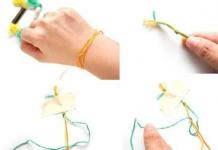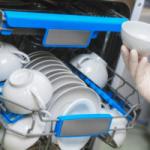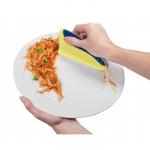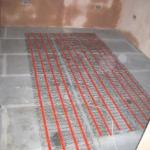Today, household appliances that wash dishes are in great demand. However, many new users have no idea how to properly load dishes into the dishwasher in order to clean them thoroughly. After the washing process is completed, streaks often remain on the plates. Today's article will tell you how to solve this problem.
The dishwasher has 3 sections:
- upper;
- lower;
- removable.
Below we consider their location and main purpose.
Glasses, mugs, and other small dishes are placed in the upper section. Mugs and glasses should be placed upside down, slightly at an angle so that water drains and does not collect in their recess. On the left is a rack on which bowls, small bowls, saucers are placed.
Some dishwashers are equipped with a special holder. It is used in different ways. This element is especially indispensable for washing elongated wine glasses with a narrow neck. It allows a jet of water from the rocker to wash the inside of the container. In addition, the holder is used for the rational arrangement of coffee or tea cups. The top compartment can be removed if desired.


This compartment is considered the main one. Bowls, plates are arranged according to the rules of the upper compartment. Large flat dishes are arranged on the sides, and small and deep ones in the center. This arrangement ensures effective washing. Flat utensils (pans, baking sheets) are placed in an upright position to better clean and allow water to wash the remaining dishes. Pots in this area are placed upside down. Large utensils are recommended to be washed separately from other utensils.
In some models, the bottom tray is completely or partially transformed so that bulky dishes can be washed. When the holders are folded, you can put something bulky in the compartment.


Removable tray
The purpose of this device is high-quality washing of cutlery and kitchen knives. The main working element of the dishwasher are the middle rocker arms. Nothing should prevent their free rotation.


Preliminary preparation
When preparing cookware and utensils for loading, it is important to adhere to the following recommendations. First you need to study the instructions for using the device, find out what type of pollution this device copes with. Usually, difficulties appear when cleaning dishes from a baked dish or protein food.
So, before you put the dishes in the trays, you need to clean it from the remnants of food. Otherwise, the drain system of the device may become clogged. Bean grains, fruit bones, corn should not be allowed to remain on the dish. It is also necessary to pour out the remnants of the tea leaves, remove the oil from the pan. When sweeping the remaining food into the urn, do not use cutlery, serving knives, as they will scratch the coating. For cleaning, use a sponge, cloth or rubber spatula. Next, rinse the dishes with water so that it is better washed.
Dishwashers are equipped with filters. They should be checked before starting the machine. If the need arises, they are changed. Important is the filter, which is located in the hose connected to the water pipe. This filter must not be allowed to become clogged, otherwise there will be difficulties with the water supply, and this will not allow for high-quality cleaning.
Make sure the hose is securely connected to the mounting hole. If the dishwasher has not been used for a long time, “run” it empty, and then load the dishes. This will clear the hoses of stagnant water.

Before placing the dishes in the dishwasher, it is necessary to remove food residues from it.
Rules for arranging dishes
The arrangement of dishes in the dishwasher depends on the manufacturer of household appliances and its type. Most often there are options in one or two tiers. Large items (saucepan, pan) are first loaded into a single-tier machine. They are placed in the middle. Plates are placed between special teeth, cups - on the sides. The arrangement of items in the dishwasher may have other options.
Many are interested in how to load dishes into the dishwasher? Different models of this type of equipment differ in internal design. However, the placement of dishes comes down to general recommendations.
Small but deep plates and bowls are placed in the upper compartment:
- gravy boats;
- bowls;
- bowls;
- saucers.
They are placed on top, upside down, under a large slope. To wash the bowls well, you should arrange them freely. If there was no place for them in the upper section, then you can place them below (secured with special teeth). Flat plates are placed in the upper section at the bottom, with the inside towards the middle, at a slight slope. This is due to the fact that in many dishwashers, the nozzles spray water from the middle to the edges.
Glasses are also placed in the upper zone. The legs of wine glasses are inserted into special cells. To fix wine glasses, cups (for tea and coffee), use a plastic holder. However, objects should be well secured so that they do not turn over under the pressure of water.
In the device, you can wash a cutting board, skimmer, if these utensils are not wooden. The listed items are placed horizontally. Bulky utensils (pot, stewpan) are laid in the lower section, upside down, at a slight angle. In this case, it is desirable to wash large utensils separately from fragile products.
Cutlery is placed in the small compartments provided in the loading box. The cutlery is placed with the handles down, since the horizontal placement of knives, forks, and spoons is considered the safest. You can not place the cutlery too close to each other, otherwise the washing will be of poor quality. It is recommended to alternate between them. But it is advisable to install large cutlery at the top in a horizontal position. So they will not block the flow of detergent from the sprayers. The knife should always be placed with the blade down!
After loading the dishes, make sure that nothing is blocking the detergent drawer. If the compartment is blocked, this will reduce the quality of washing. Products must not be allowed to touch. This will block the free access of water to the dishes. It is also not recommended to overload a small dishwasher, the dishes will not be washed, but there will be disappointment from using the technique. Each washing machine has its own loading subtleties. If everything is done correctly, then the device will become as productive as possible. It will definitely make life easier for the owners of this household appliance.

Mode selection
It is important not only to properly prepare household appliances for work, to put the dishes correctly, but also to choose the optimal washing mode. How to choose the right washing mode, consider the example of Bosch equipment, which has 4 modes:
- 70 ° С - for large containers or too dirty dishes and utensils;
- 50°C - for medium soiled dishes;
- 45°C - for washing glass or lightly soiled items;
- rinsing - it is recommended to apply when the food has dried to the dishes.
When washing fragile items, select the "Delicate wash" mode. Please note that the "Quick Wash" mode saves water, electricity and time.

Use of special tools
After loading the kitchen utensils, pour the detergent into a special compartment. It must be ensured that this compartment is not wet, otherwise the machine will not be able to wash the powder out of it. The chemical will remain on the dishes and then get on the food, causing a health problem.
The dishwasher must not be used with manual detergents. These solutions lead to strong foaming, which threatens to stop the machine and even damage it.
It is necessary to use special degreasers designed for dishwashers. Every 4-6 months during the operation of the machine, it is necessary to add an anti-scale agent to the detergent. It will effectively clean the surface of the device parts from accumulated deposits.
Many owners of dishwashers are faced with the problem of selecting detergents. The modern market offers the following types:
- powders;
- liquids;
- pills;
- gels;
- conditioners.
It should be noted that today powder is in great demand, as well as rinse aid. A single portion of detergent depends on the filling capacity of the equipment. On average, 40-50 g is enough. The compartment has marks that allow you to control the detergent. In another compartment, rinse aid is poured, the volume of which also depends on the number of dishes. As for tablets, 1 tablet is enough for one washing cycle.


Below are tips that allow you to make washing high-quality, and the performance of the device - high:
- it is undesirable to put dishes in the device whose height is greater than the height of the lower compartment, as it will prevent the door from opening after washing is completed;
- it is advisable to send dishes that are too dirty after eating to the car, where food remains will not dry out and can be easily removed;
- if the dishes are heavily soiled, it is recommended to pre-soak them in water, with the addition of baking soda;
- if there are too many dishes, it is recommended to wash them gradually, loading the same items;
- when there are few dishes, it is better to place it in the middle, since some dishwashers have one rocker (spray), which often cannot wash the entire compartment with the same quality;
- fragile dishes are placed so that the distance between the products is maintained. The vibration that occurs during washing can harm them;
- plastic objects should be placed away from the heating element, with the inside down (that is, if the heater is on the bottom, then the plastic is placed at the top, and vice versa). This arrangement minimizes the effect of high temperature on the item and prevents it from melting;
- collapsible dishes should be loaded in parts: each element separately;
- in one cycle, you can wash from 6 to 16 sets of dishes. It all depends on the specific model of household appliances and the contents of the kit (as you know, many kits differ not only in quantity, but also in the size of dishes);
- if the filter of the machine is clogged, then it is better to wash the dishes by hand;
- deactivating the drying function will save energy;
The removal of dishes begins from the lower box so that the water flowing from the upper dishes does not fall on the lower tier, otherwise there will be streaks.
What dishes can not be washed in the dishwasher
When working with a dishwasher, you need to understand how to properly arrange the dishes in the dishwasher, as well as what dishes are contraindicated in this device. Do not put in the dishwasher:
- products made of silver or aluminum;
- copper and tin objects;
- products made of thin glass and crystal;
- plastic utensils;
- utensils with teflon coating.
These materials deteriorate (darken, melt) from detergents and high temperatures. It is also advisable to wash wooden utensils by hand, as the wood can crack from the high temperature of the water. In addition, this natural material strongly absorbs food residues into its surface. It is also not recommended to load sharp and ceramic knives into the machine - so as not to dull the blade.
So, everyone can figure out how to properly arrange the dishes in the dishwasher . Over time, experience will come in the rational stacking of dishes, pots, cups and wine glasses. And in the future, this process will take a little time.
Video
There is absolutely nothing difficult in loading the dishwasher, but with the right approach, your dishes will be much cleaner. Using your dishwasher to the maximum, you will save a lot of time and effort.
Steps
- Make sure that the surfaces of the plates do not touch each other and are accessible for the flow of water from the nozzles.
-
Arrange cups, glasses, and small bowls so that they are exposed to water from the lower compartment. Arrange the bowls on a slight slope so that the detergent can penetrate and the water can drain freely. This will also allow you to fill up more space than if you simply stacked the dishes face down.
- Do not pack or overload the dishwasher. If any item of dishes does not fit, wash it by hand.
- If necessary, wash large items by hand or reload the dishwasher.
-
Arrange the plastic containers on the top tray. Since the heating element of most dishwashers is at the bottom, you should not place plastic items there, otherwise they may melt or deform.
Load the cutlery basket, separating them as much as possible. Place knives, forks and spoons in the special basket with the handle down. As a rule, it is better to wash dangerous or sharp knives by hand, as the dishwasher can dull them. Do not put cutlery with wooden handles or wooden utensils in the dishwasher.
- Arrange cutlery separately from each other, but so that water can easily reach their dirty surfaces. Proper sorting is the key to a quality wash.
- Large cutlery can block water sprinklers, nozzles and rotating nozzles. These items are best placed on the top tray in a horizontal position.
- Place large kitchen utensils on top of the dishwasher. Place serving spoons cup side down so that water does not collect in them.
-
If cutting boards and large trays won't fit into the plate trays, place them on the outside of the bottom rack of the dishwasher. Keep in mind that high temperatures can warp cutting boards, so it's best to wash them by hand.
Place the wine glasses on the plastic rack in the top tray. If your dishwasher has a fold-out plastic compartment with cells in the top tray, then it is just designed to hold the thin legs of wine glasses. Thus, you will save fragile glasses from scratches and cracks.
Before starting, make sure that the rotating nozzles and spray arms turn freely and that the tubes and nozzles are not obstructed. Also check that the detergent container opens completely. If any of these parts are cluttered or blocked, it will be much more difficult for you to achieve a quality wash.
Fill the special container with powder detergent located at the bottom of the dishwasher or on the door. Fill it up to the required level. If you are using detergent tablets, place one tablet in the bottom of the dishwasher door. Depending on the temperature of the water and the length of the wash cycle, some of the tablet coating may not completely dissolve, resulting in clogged pipes. Because of this, some dishwasher manufacturers do not recommend the use of detergent tablets.
- If your dishwasher has two detergent containers, fill the one on the door first. It should open after the dishwasher finishes the pre-rinse to soften the dirt.
- Fill the second container only if the normal wash was not satisfactory or you have very dirty dishes.
-
Run your dishwasher at night to save money and energy. Not only does your dishwasher not have to compete with other appliances for hot water, it will not only increase efficiency, but it will also save you money. Appliances such as dishwashers tend to load the home electrical network, increasing energy costs. Using it at night, when the network is less loaded and the temperature is lower, is the most effective solution.
How to get the most out of your dishwasher
-
Scrape large leftovers from the plates into the trash can. Be sure to remove bones, heads, seeds, fruit peels, and the like. You must remove all large and dried food residues, as even small grains of rice after washing in the dishwasher can remain on the dishes. If you do not want to wash all the dishes, take a fork or a napkin and wipe the food off the plates.
- Rinse dishes if necessary. Most dishwashers and detergents do their job better when they have something to wash. If the dishes are not washed well, try rinsing the plates before the food dries and hardens.
-
Find out what your dishwasher cleans and what it doesn't. Washing protein foods like eggs and cheese, cooked or baked foods, and dried starch requires special attention. Lightly soaking and scraping off food residue will increase the efficiency of your dishwasher. You can also soak the plates in the sink before loading.
Use a rinse aid or "pre-wash" to keep your plates clean and streak-free. This will reduce the formation of drips on the surface of the dishes, especially if you have hard water. The rinse aid does not need to be filled every time the dishwasher is used, it is enough to do it every few weeks or every month, or according to the instructions for use.
- In a pinch, you can replace commercial rinse aid with white vinegar, which is almost as effective.
- Some dishwasher detergents already contain a rinse aid. Read the label.
- If you have a water softener or your water is soft enough to begin with, you won't need a rinse aid.
-
Before turning on the dishwasher, run waste disposer . It is very common for a dishwasher to be connected to a sink pipe, which is why it is so important to keep the pipe clean. If you don't have a garbage disposal, use a strainer in your sink drain to keep crumbs and other debris out of the drain.
If your detergent does not contain phosphates, you can wash dishes in cold water. Modern detergents no longer contain dangerous phosphates, replacing them with enzymes that react at any water temperature. This will save you energy and money.
Open the hot water faucet and wait until hot water comes out. Dishwashers, although they can heat the water themselves, but with already hot water, washing will become more efficient. If you do not want to drain the water down the sink, collect it in some container to use later for watering flowers or for other needs.
Do not overload the dishwasher, as this will negatively affect the removal of food residues from the plates. Do not stack dishes on top of each other or try to stuff them at odd angles. Dishes should be tightly packed, not stuffed to capacity. If the washing result is unsatisfactory, consider what could have caused this. Perhaps by overfilling the trays, you thereby prevented some dishes from getting improperly cleaned?
-
Insert the plates into the trays at the bottom of the dishwasher. Point the plates towards the center and tilt them forward. This is done because pipes, nozzles and rotating nozzles spray water from the center out. In the dishwasher, water is sprayed on the sides, falling from top to bottom and rising from bottom to top.
Proper loading of dishes in the dishwasher is one of the main conditions for high-quality washing. The first time loading may require at least 20 minutes of time to arrange everything carefully and thoughtfully. But over time, everything will fall into place, and you will complete this procedure in less than 10 minutes. On how to deal with loading dishes, we propose to understand and watch the video.
How to prepare dishes
Before you start laying out the dishes in the compartments of the dishwasher, you must remove all the remnants of uneaten food. And the better this is done, the better the dishes will be washed and the less chance that the drain system of the machine will clog. You can clean the dishes with a napkin, sponge or rubber spatula, it is especially important that there are no bones left from fruits, as well as legumes and corn.
Should I rinse my dishes before putting them in the dishwasher? Of course, if you rinse the dishes under water, they will wash better. Then a counter question arises, why do you need a dishwasher if you have to wet your hands? If you accumulate dishes, then you can’t do without pre-rinsing, dried food residues are washed poorly. If you are used to washing dishes immediately after eating, then you can completely put the plates in trays without rinsing.
For your information! Some models of dishwashers have a pre-rinse mode, this is a big plus if the dishes pile up during the day.
We place glasses, cups, mugs
Now let's take a look at the different dishes and how to arrange them correctly. Let's start with glasses, mugs and cups. For them, in most dishwashers, the top tray is designed. Glasses, mugs and cups should be placed upside down so that water washes their inner surface and then flows down. Horizontal arrangement is not permissible, since water will practically not get inside.

Wine glasses and glasses are also fixed with the leg up in a special holder. The glasses should not touch each other so that the fragile glass does not break during the washing process. The plastic holder can be used not only for glasses, but also for the rational placement of small tea or coffee cups.
Important! All items must be well fixed, otherwise something may turn over under the stream of water. When sliding the top tray, nothing should hang out.
Stacking various plates
Depending on the size of the plates and the purpose, they are placed on both the upper and lower trays. On the top tray, if the capacity of the dishwasher allows, you can place:
- small pigtails;
- bowls;
- bowls;
- saucers;
- bowls;
- gravy boats;
- salt shakers;
- dessert plates.

If necessary, and when the water is heated to a low temperature, plastic dishes can be laid out on the top shelf, away from the heating element, so that the objects are not deformed.
On the lower tray are placed plates of large and medium diameter, plates for soup. In this case, it is better to place plates of a larger diameter at the edges, plates of a smaller diameter in the center. This will ensure better access of water to the upper tray with dishes. In addition, the plates must be placed facing the center of the dishwasher so that they do not touch each other. The larger the gap between the plates, the better they are washed, so if the dishwasher allows, then put the plates less frequently. It makes no sense to overload, the dishes will remain dirty, and you will have a disappointment in technology.

Arranging cutlery correctly
For cutlery, which includes large and small spoons, forks and serving knives, a special basket is provided in the dishwasher. You need to arrange spoons and forks freely and it is better to alternate them with each other, this will be correct. If you fold the spoons tightly together, they will not be washed. Knives should be placed with the blades down.

In new models of dishwashers, such as the Bosch brand, there is a top-most tray for cutlery. The arrangement of spoons in such a tray is horizontal. This ensures not only high-quality washing of dishes, but also an economical distribution of space inside the dishwasher. In addition, the horizontal arrangement of spoons, forks and knives is safer.

Important! It is not recommended to wash sharp and ceramic knives in the dishwasher, as the blade may become dull. Do not wash knives with a wooden handle, as the wood will swell from prolonged exposure to water.
How to arrange pans and pots
As for the large utensils necessary for cooking: frying pans, pots, stewpans, baking sheets, etc., they are placed in the lower container. It is best to wash such dishes separately from dishes made of glass, porcelain and crystal, choosing for this a more intensive mode at a high temperature.
So, pans and baking sheets must be placed sideways, and pots upside down or at an angle. This is the only way to ensure maximum access of water to all dishes in the dishwasher. If you put pans upside down, they will block access to the upper tray.

Important! Some frying pans and other utensils that have a Teflon coating are prohibited from washing in the dishwasher by their manufacturer, so be careful.
If the handle is removed from the pan, be sure to remove it. Place a pan with a handle so that it does not touch the walls of the dishwasher. When the pans are positioned as in the photo below, access to the upper tray with dishes will be limited, so we do not recommend putting anything in it. In this case, you can use the "Half Load" function, which will save not only water, but also electricity. Trays should be correctly placed sideways along the edges of the lower dishwasher tray, even if there is no special nozzle, then water access from the lower spray arm will be sufficient.

Can you wash kitchen utensils in the dishwasher?
Kitchen utensils, which include cutting boards, ladles, skimmers, spatulas, can be washed in a dishwasher, provided that the spatulas and boards are not wooden and preferably not plastic. Plastic spatulas can be placed in the uppermost dish tray, cutting boards in the side compartments of the lower or upper tray, depending on the size of the board. But if possible, it is better to wash the boards by hand.
Ladles and spatulas should only be placed horizontally, even if there is no special compartment for them, there is enough space in the upper compartment for them.

Putting the dishes in the dishwasher according to all the rules, the question arises of how many dishes can be washed in one cycle. The manufacturer indicates in the instructions the capacity in the number of sets. Small machines can hold up to 6 sets, narrow up to 11 and full-size up to 17 sets of dishes.
However, the sets, not in quantity, but in the size of the plates, may be different. Also, some may only use soup and salad bowls and not use saucers. Therefore, the loading of the machine in different families may differ. We suggest following a few more rules for placing dishes in the dishwasher:
- you should not load the machine with dishes to the maximum, a larger gap between objects will allow you to better wash the products, and even more so do not overload the machine;
- before putting any item in the dishwasher, make sure that it can be washed in it, especially for plastic products, fragile glass and crystal wine glasses;
- place objects so that they do not touch each other;
- if possible, wash pans and pots separately from plates, mugs and glasses;
- do not wash wooden items in the dishwasher;
- if you prefer to collect all the dishes in a day, then it is better to immediately place dirty dishes in the machine, they will not dry out in it and then it will be easier to wash off.
So, correctly arranging the dishes in the dishwasher compartments is not so difficult. After several washing cycles, you will do this automatically. We hope our article will help you cope with this, you can also watch this interesting video.
Do not rush to immediately load all the dirty dishes into it. The quality of washing and the service life of the equipment directly depend on how correctly this is done. Dishwashers are designed to make life easier. But do not count on the fact that they will completely free you from manual work. Certain types of kitchen utensils and items are not suitable for washing in a dishwasher. In addition, the dishes must be able to properly place in the mechanism.
For more information on how to properly load dishes into a dishwasher (PMM) and how to properly operate kitchen appliances, read the article.
Preliminary preparation of PMM
Before you start loading the dishes and press the "Start" button, do not forget to pour salt for PMM into the compartment intended for this. Do this about once a month. Regardless of the chosen detergent (“3 in 1”, “7 in 1”, etc.), we do not recommend neglecting salt. Appliances will last longer and dishes will be cleaner.
The same goes for rinse aid. Despite the use of multifunctional detergents, the rinse gel will add shine to clean dishes and will not leave powder streaks on them.
Periodically inspect machine filters and clean or replace if required. First of all, clean the filter located on the pipe connected to the water supply.
Check the tightness of the hose connection. Make sure the sprinklers are clean and free to rotate. The holes are often clogged with food if it is not removed from the dishes before loading into the PMM.
If you have not used the appliance for more than three days, run one wash cycle without dishes. So you drain stagnant water from the pipes.
Disassemble the dishes, consisting of several parts. If this is not done, strong water pressure may damage the docking elements. If there are a lot of dishes, sort them by type.
Remove food residues from dishes, rinse items with dried dirt immediately before loading. If the pollution is strong, pre-soak for half an hour or an hour in warm water.
Attention! When soaking dishes, do not use conventional hand washing products. They will lead to excessive foaming and can damage the equipment.
Can you wash kitchen utensils in the dishwasher?
This question is difficult to answer if you do not know what material the dishes are made of. . For example, wooden objects are not intended for mechanical washing.. Therefore, wooden boards will have to be cleaned manually. Ladles and skimmers made of stainless steel can be washed in PMM. They are laid horizontally.
As for plastic items, such as spatulas, in most cases they can also be washed in the PMM. But it all depends on the plastic itself. For example, plastic ladles and spatulas that are included with the multicooker are allowed to be washed in a typewriter.
This is written in the instructions for the household appliances themselves. It is better to put such items on top, and plastic boards on the sides. Spatulas and ladles with short handles are also placed in the cutlery tray.
Rules for loading cutlery
Each PMM has a place reserved for cutlery. These are either shelves on top, designed for their horizontal arrangement, or special removable baskets (most often). In the latter, spoons, forks and knives are arranged vertically in a certain pattern.
The knives are set with the tip down so that they do not scratch the inner surface of the PMM. The rest of the appliances are placed in the basket with the handles down. The washing performance will be reduced if cutlery is placed too close to each other.
It is recommended to alternate them (fork, knife, tablespoon, knife, etc.). Teaspoons are placed closer to the center of the cutlery basket. Large utensils are located horizontally at the top of the PMM, otherwise it will block the sprayers.
Advice! Sharp knives are best handled by hand. From washing in PMM, the blades quickly become dull.
How to arrange cups, glasses, glasses and stemware
Items for drinks are placed in the upper basket at a slight slope, bottom to top. For glasses in the basket, removable elements with recesses are provided. They hold the legs of the wine glasses during washing. Small coffee cups are placed on top of such elements.

How to stack plates and bowls
Small bowls, dessert and patty plates are placed in the upper basket. There is also a place for gravy boats, bowls, salt shakers and bowls. The lower basket is designed for soup and large bowls. In this case, large dishes are placed on the sides, and smaller plates are located in the center of the tray. This allows water to reach the top basket.
In case of severe contamination, the plates are placed through one hole, increasing the space between them.
How to arrange pans and pots
Pots and pans are placed in the lower compartment of the PMM. Removable handles are removed and placed separately. Pots are placed upside down, and pans are placed vertically, slightly at an angle. Baking dishes and baking sheets are also washed in an upright position. Large dishes are placed along the edges of the lower compartment.
Attention! Frying pans with pots and glassware and porcelain are washed on different PMM programs.
Dishwasher incompatible dishes

Due to the high temperature and detergents used in the PMM, not all dishes are subject to processing in the machine.
Items made from the following materials are not compatible with the dishwasher:
- aluminum- darkens from prolonged exposure to water and hot steam;
- tree- collapses under the influence of moisture and temperature differences;
- cast iron- the protective layer is washed off and rust appears;
- copper, tin and silver- oxidize and blacken;
- porcelain and plastic- most varieties of these materials do not tolerate temperature extremes, but in some PMMs there are special short and low-temperature programs for them.
- Teflon-coated pans - under the influence of aggressive detergents, the protective layer is washed off, and they lose their non-stick properties;
- sharp knives - when heated, they become dull;
- utensils with decorative painting - the paint can be washed off;
- dishes with a vacuum lid, a sealant - hot water violates the seal, the sealant deteriorates;
- objects stained with paint, ash, grease, wax - will stain the equipment and lead to clogging;
- appliances with rust - washing in PMM will lead to even greater destruction and corrosion on metal objects that have not yet been touched.
When buying kitchen items, pay attention to the labeling. Manufacturers usually write on the label whether washing in the dishwasher is allowed.
How many dishes to load per wash cycle
So, how many plates, pans, cutlery will fit in the PMM? It depends on the size of the dishwasher. The instructions for the equipment always indicate its maximum capacity. It is expressed in sets.
A standard dishwasher can hold up to 12 sets, a full-size dishwasher can hold up to 16, a narrow one - 9, and a compact one - no more than 6. Under a set, the manufacturer understands 2 plates, a saucer, a cup, a glass and cutlery. But in reality, when you have to load additional pots and pans, there will be much less sets of dishes.
As we can see, the capacity of the PMM can vary greatly. But there are general rules, adhering to which you will always be satisfied with the result of washing.
- Before you send the dishes to the machine, make sure that they are designed for washing in the PMM. Fragile glass goblets, thin plastic items should only be washed in special modes at a water temperature not exceeding 45°C and washing duration up to 1.5 hours.
- Do not load PMM with dishes to the maximum. Leave a small distance between objects so that they do not touch each other. So the products will be better cleaned.
- Heavily soiled pots and pans should be washed separately from glasses, plates and mugs. For them, modern PMM provides a special high-temperature regime with a longer washing cycle.
- Put away dirty dishes in the PMM immediately after eating. So the food remains do not dry out and are well washed. Rinse the dishes with dried mud beforehand.
Conclusion
It does not matter what brand and capacity you have PMM. For a good result, it is important to properly load the dishwasher. This is 80% success, and only the remaining 20% are detergents.
After several correct downloads, you will already place kitchen items in the PMM in the right order and quantity automatically.
In fact, loading the dishwasher is not difficult, but if you do it in a certain way, it will significantly improve the quality of the process, as well as significantly save time, energy, and get an excellent result. Before loading dishes into the dishwasher, you need to clean your dishes from food residues.
If the filter of the machine is clogged, this will create a large load on the pump, which will certainly lead to pump wear over time.
Let's figure out how to properly load the dishes in the dishwasher.
Arrange the dishes on the bottom racks of the dishwasher. Make sure they are in the correct direction, i.e. hollow side to the center. If the compartments are sloped, then the plates should be tilted down and also turned to the center with the hollow side.
In most dishwashers, the location is:
- Top Tray– for mugs, glasses, glasses, and small dishes.
- bottom tray- for frying pans, pots, plates.
- Bucket or plastic tray- for knives, forks, spoons, and so on.
This is because the pipes and rotating arms spray streams of water from the middle to the outer surface. Water descends both from top to bottom and out and vice versa. It must be ensured that the surfaces of the dishes are separated from each other so that the jets of water can easily rinse them.

All glasses and glasses should be set slightly at an angle so that the water spreading from below can easily reach their bottoms. Arrange the cups in an orderly manner so that the detergent can easily wash all of their inner and outer surfaces and flow down unhindered.
With this arrangement, you make much better use of the bay spaces than with a direct arrangement.
Place the plastic containers on top of the machine. It is better not to place them in the lower compartment, because the heating element is located in its very center and when heated, the plastic is especially prone to deformation.

In order to properly load the main dishes, you need to sort them. Feel free to place pots and pans in the lower compartment, but especially do not overload it. Be careful when washing Teflon-coated pans, such pans are best washed by hand.
It should be noted that, and other aluminum dishes can not be washed in the dishwasher! Aluminum darkens during the washing process and loses its normal appearance.
Place large cutting boards and bowls around the outer perimeter of the lower compartment if you can't fit them in the plate slots. But still, it is better to wash the cutting boards by hand, because the tree is subject to deformation at high temperatures.

How to load forks, knives, spoons, etc.? Place the cutlery in a special bucket, placing them with the handles down. Particularly large and sharp knives are recommended to be washed by hand due to the fact that they are easily blunt. Other kitchen tools or tools with wooden handles should also not be washed in the dishwasher.
Too long handles on knives or other utensils can block the screw, so they should also be washed by hand, or placed in the upper compartment of the machine.
All forks and spoons should, if possible, be separated from each other and from the rest of the utensils so that they are within easy reach of water. The more carefully you distribute the cutlery, the cleaner it will be at the end of the wash.
Place various ladles and ladles on top with the hollow side down. In this way, they are better washed thanks to the downward jets.

For crystal and glass goblets, use the special holders located in the top compartment of the dishwasher. In some models, such fasteners are also present at the bottom. They perfectly fix the stem of the glass to avoid damage and scratches on the glass.
Before each wash cycle, make sure that the plastic screw can be rotated smoothly in the correct direction without touching the dishes. Also check the plastic compartments for detergent. They must be open and their openings must not be clogged.
Pour the detergent into the correct compartment. Use powder or liquid soap. Pay attention to the marks indicating the acceptable level.
If you are using a tablet, you can put it next to the door. Be also careful when choosing detergents. Some washing cycles are carried out at low temperatures, at which the tablet may simply not dissolve. Because of this, the quality of the wash may suffer, as well as the risk of blockage of the sewer pipe.
If your machine has two compartments for detergents, choose the first one. It is usually not programmed for prewash. If your dishes are especially dirty, use the second compartment used for soaking.

How to put dishes in a Bosch dishwasher.
How to make the best use of all the resources of the dishwasher
- Do not place dishes with leftover food in the machine. To do this, use a paper towel, fork, rag napkin. Even the smallest crumbs are able to clog the filters, and of course you will not get the desired result. Use the soak program only when necessary. If the dishes are not washed well, you can spray them with a spray bottle and repeat the washing cycle.
- It is worth remembering which foodstuffs are difficult to wash. Egg whites, cheese, starch - these products that have had time to dry on the dishes need special attention. Soak dishes in the sink before placing them in the washer.
- If necessary, use a rinse aid and a prewash soak. With these products, your dishes will not only be perfectly washed off food residues, but will also avoid water smudges. There is no need to fill the rinse aid compartment every time, it is enough to do it once a week or a month. This is usually indicated in the instructions for use.
- Try changing your rinse aid to white vinegar. Many detergents already contain rinse aid, so it's always a good idea to read the label carefully before using the contents. If your water supply structure is equipped with a water purification system, rinse aid may not be useful.
- Before starting the machine, make sure that the drain filters are in good condition. This will help you avoid blockages in the pipes.
- Remember that you can use a cold water wash cycle. When it should use special detergents.
- Before using the dishwasher, turn on the hot water faucet and let it run. Modern electrical appliances are equipped with a water heating system, and thus you will avoid unwanted costs.
- Do not overload the machine, otherwise you will find food residues on its internal surfaces. Make sure to fill the space evenly. If you are not satisfied with the wash, try to understand the problem. Often the solution lies in the proper loading of dishes.
- Turn on only the filled machine. This way you save time.
- Store powder products only in a dry place.
- Use a short dishwashing cycle whenever possible to save energy
- Use a drying cycle. If this program is not available, open the machine door and wait for the dishes to dry.
- If you are unhappy with the cleanliness of your glass goblets, make sure no other glassware gets in the way of the streams of water that wash over them.
- Set the boiler thermostat to 50 degrees when using programs with high temperatures.
How to load dishes into the dishwasher - on the video.

















